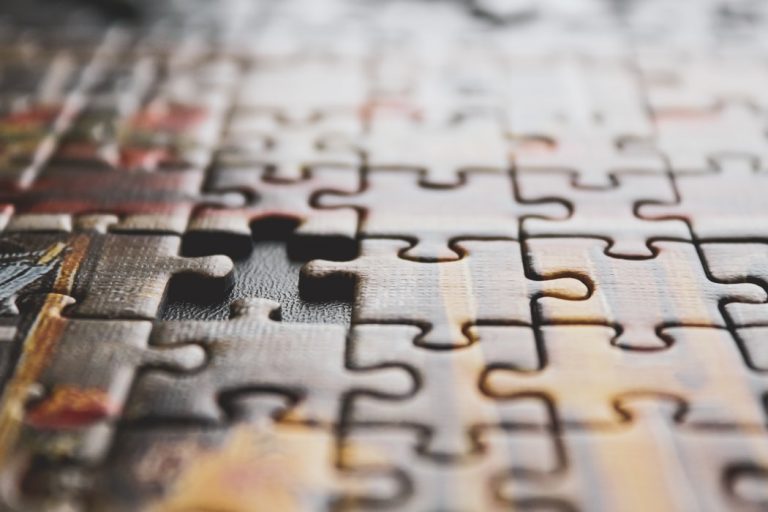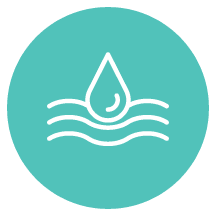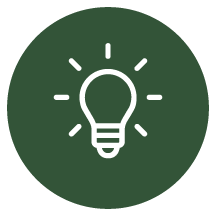“The most effective way to teach a complex concept is by identifying what is the most complex [piece], and take the time to understand it, before communicating it to your learners.”
–How to explain complex concepts blog

A system is like a puzzle. Let’s build the puzzle together, piece by piece. In this image, there are many dark brown and yellow puzzle pieces and one piece is missing (Sigmund via Unsplash).
By Noah Kaiser, Intern at Agenda for Change
In my first, second, and third blogs, I simply explained a water and sanitation system by describing the system as a puzzle. Then, I began building the puzzle with special pieces that we call Building Blocks. Here, I’ll finish putting the puzzle together by simply explaining three more puzzle pieces: Regulation and Accountability, Water Resource Management, and Learning and Adaptation.
Follow the leaders
A system works best when there are rules in place. This puzzle piece helps to make sure that all people involved know their roles and follow the rules.

Regulation and Accountability: This piece means there are instructions in place for the people responsible for providing water, and instructions for people who use the water to get help when something isn’t working.
In a strong system, governments create laws that make sure that everyone has clean water in their homes and safe places to go to the bathroom. People responsible for providing water to community members follow these laws. The government makes sure that the laws are followed and water users, who are people like you and me, have clear ways to speak up when things aren’t working.
In a weak system, laws don’t exist or are not followed consistently. Weak systems usually don’t have laws or ways for water users to communicate with the government or water providers. Similarly, the government doesn’t have a way to make sure water workers are doing their jobs properly, and this can mean that communities lose water.
All of the water in the whole world
People all around the globe have different uses for water, and it’s important to make sure that we take care of this critical resource. Many people get their water from rivers, streams, reservoirs, lakes above and below ground, and springs. The used water, which is often dirty, must be managed well so that it doesn’t make anyone sick.

Water Resources Management: This piece includes all the water in the world, whether we can see it or not, in our homes and in the natural world. We must understand where the water is, if it’s clean or dirty, and how much water there is to make sure there’s enough water for people, animals, forests, farms, rivers, and businesses.
In a strong system, different types of water users understand how much and what kinds of water they will need. Together they plan out all the water use for people, businesses, plants, animals, and all sorts of things that require more water than we realize. They also consider ways to keep natural places like wetlands and water bodies healthy and strong too.
In a weak system, people with more power use more water. This might mean that big companies use up all of the water in a particular area, or dump their trash into water that people need to drink. There is not a shared understanding or enough information for people to understand the amount of water available now, or what will be available in the future. of water available now or in the future. When this happens, people lose access to the clean water that they need to survive, as do plants and animals who depend on shared water sources.
We’re always learning
Talking to each other and sharing lessons about our puzzle-building successes and failures helps everyone do a better job of building the systems puzzle.

Learning and Adaptation: This piece includes knowing who to talk to for advice and using that information to improve our puzzle-building skills.
In a strong system, everyone who builds the puzzle knows where to get the information they need. Instead of lots of different people making the same mistakes, people can learn faster and improve their puzzle-building skills over time because there are ways to find and share information on what works well and what doesn’t work so well. When the system is strong, we all work together to build the puzzle, and to make sure that the next generation of puzzle builders will be even better.
In a weak system, people who hold pieces of the puzzle might not realize that they need to talk to other people about their puzzle pieces. Even if they do, they don’t know where to go or who to ask for advice about how to place their piece correctly with along with all of the other pieces. People keep making similar mistakes over and over, and this means that many people around the world have to continue living without clean water or a safe place to use the bathroom.
The puzzle building continues…
In this blog series, I explained WASH systems using the analogy of a puzzle, and described what it means to make those systems strong using eight important puzzle pieces called Building Blocks.
A complete puzzle usually shows a beautiful image. At Agenda for Change, we are working collectively to complete a puzzle that shows all people on earth having safe water to drink and to wash hands with, and a safe, clean place to use the bathroom, forever. We will keep building the puzzle together!

Noah Kaiser is an Intern at Agenda for Change who is passionate about the application of systems-thinking in a global WASH sector. He also works as a teaching assistant and research assistant within the Mortenson Center in Global Engineering, at his alma mater the University of Colorado at Boulder, from which he holds a BS in Mechanical Engineering and an MS in Civil Engineering. Noah’s research and career interests span WASH, rural transportation infrastructure, disaster risk reduction, food security, and the humanitarian aid and development nexus.
